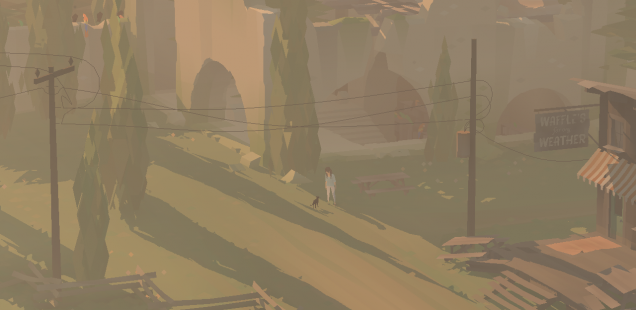
Opened World: Kentucky Route Zero Act V
Miguel Penabella finds community and catharsis in saying goodbye.
This is the final part of a comprehensive overview of Kentucky Route Zero. See also: Part one, part two, part three, and part four.
I first discovered what was killing these men.
I had three sons who worked with their father in the tunnel:
Cecil, aged 23, Owen, aged 21, Shirley, aged 17.
They used to work in a coal mine, not steady work
for the mines were not going much of the time.
A power Co. foreman learned that we made home brew,
he formed a habit of dropping in evenings to drink,
persuading the boys and my husband—
give up their jobs and take this other work.
It would pay them better.
– Muriel Rukeyser, The Book of the Dead.
To inhabit oneirically the house we were born in means more than to inhabit it in memory; it means living in this house that is gone, the way we used to dream in it.
– Gaston Bachelard, The Poetics of Space, 38.
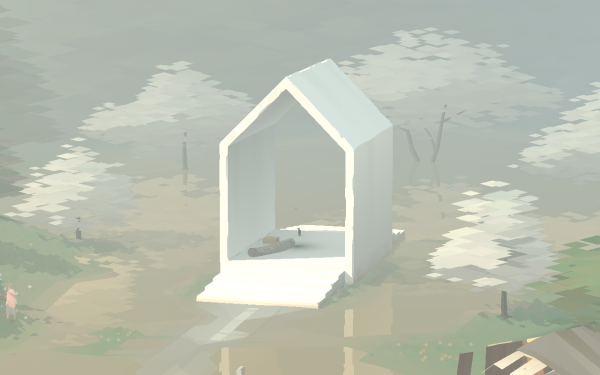
I’ve been playing Kentucky Route Zero for seven years. The journey of characters Shannon, Ezra, Julian, Johnny, Junebug, Will, Cate, Clara, Weaver, Conway, and his dog has been unfolding over the course of a single night. Motivated by a package delivery to the mysterious 5 Dogwood Drive, Conway’s travels have steadily plunged deeper into the dark recesses of a dreamlike Kentucky otherworld, as each passing act carries the accumulated sorrows of its wanderers. Act V immediately reverses this, as characters emerge—for the first time since the twilit opening at the Equus Oils gas station—into lustrous sunlight. Climbing up from the cavernous, underground Echo River of Act IV, Kentucky Route Zero’s ensemble finally arrives at 5 Dogwood Drive and the isolated town that houses the exploited workers of the Consolidated Power Company. And yet despite the visual warmth that daylight brings, it also illuminates the destruction that the Company has wrought. Following a torrential downpour that has been building throughout the acts and violently unleashed in interlude Un Pueblo de Nada, the aboveground world presents half-destroyed homes, drowned horses, and the wreckage of the beloved video archive of WEVP-TV, the public access television station at the heart of the aforesaid interlude. Moreover, the daylight reveals the conspicuous absence of Conway after being snatched away at the close of the previous act. Shannon’s choice of interpretation of his disappearance at the end of Act IV—“He left” or “They took him”—lingers in the mind as characters complete Conway’s final job. This concluding chapter of Kentucky Route Zero bids farewell to the protagonist, serving also as a wistful denouement to the flooded town itself.
In lieu of Conway and no longer in control of any of the main cast, players instead navigate a stowaway cat who observes the different characters and their interactions. Great pleasure comes from running and leaping across flooded fields as the cat bounds through the expansive town, with its old wooden homes and antediluvian structures. Shrouded in a morning haze, the town exudes the feeling of summer heat and the mugginess of the South, recalling also the dusky, earthen colors of Cardboard Computer’s Neighbor. Alongside a crumbling church and old ruins populated by crows and parrots, 5 Dogwood Drive rises from the waters. Both ultramodern in its minimalist frame and ancient in its temple-like appearance, the structure is an appropriately unearthly presence where characters gather to complete Conway’s delivery by hand-carrying the antiques from his delivery truck abandoned belowground in the Echo River. We wordlessly eavesdrop on conversations including those of the derelict cast of Un Pueblo de Nada, now joining an already sprawling ensemble.
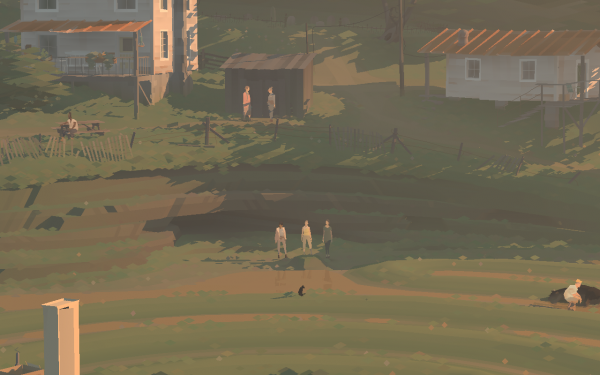
Prior to Act V, Kentucky Route Zero mostly unfolds linearly towards 5 Dogwood Drive, but now that Lysette’s antiques have finally been delivered, the game turns circular. The camera, positioned at the center of town, rotates as players direct the cat around the neighborhood, providing a full view of the drenched landscape and the extensive cast that slowly roams outward. No longer tasked with an immediate objective, the main characters join others in the gradual renewal of a community. In a long interview with Andrew Kuhar, designer Jake Elliott notes the function of the circular camera as eliminating the central ego of prior acts, replaced instead with the sense that “you’re really playing as the community.” The gameplay partly reinforces this communal experience, doing away with previous acts’ mode of engaging with dialogue via singular conversational responses. Individual dialogue is sometimes excised in favor of hypertext embedded into omniscient descriptions of scenes, a narrative strategy perhaps most recognizable from the recent work of Twine games, giving players a broadened perspective. From the very first scene of Kentucky Route Zero, the story has been steadily transitioning from individual to collective. Beginning with the limited point-of-view of Conway and his dog, each act shifts our perspective outward as we connect with other lonesome drifters mired in debt, until by Act V, a tangible community emerges. Being alone, the game suggests, leaves individuals both vulnerable to capitalist exploitation and selfishly competitive for fear of obsolescence, but solidarity—through unions, communities, congregations, families, friends—can withstand any storm.
This final act picks up the pieces of a particularly devastating storm, salvaging not just the muddied and waterlogged VHS tapes of the WEVP-TV archive, but also the whole town itself. Narratively framed with the evocative intertitle “We saved what we could,” Act V carries a more hopeful sense of possibility. No longer holding dominion over the town, the Consolidated Power Company long departed when it was no longer in their financial interests to remain. Like the noticeably absent Conway, the legacy of the Company haunts the town like a ghost, its presence still felt. The café Waffles for any Weather advertises “coffee and tunes,” but weatherman Elmo informs Johnny that the Company store once occupied the space and that during those times of clandestine labor union struggles and police surveillance, “I was in fear of my life half the time.” Slowly, however, these spaces of hurt acquire new purpose as the scars of the parasitical Company heal and a self-sustaining community takes its place. Act V’s circular camerawork allows time to move elliptically, chronicling the renewal and repopulation of the town though the suggestion of the passage of time, from dawn to dusk. As the cat darts around the landscape, characters will have relocated to different places, appearing and disappearing with each new interaction, as though players have experienced the full length of a day.
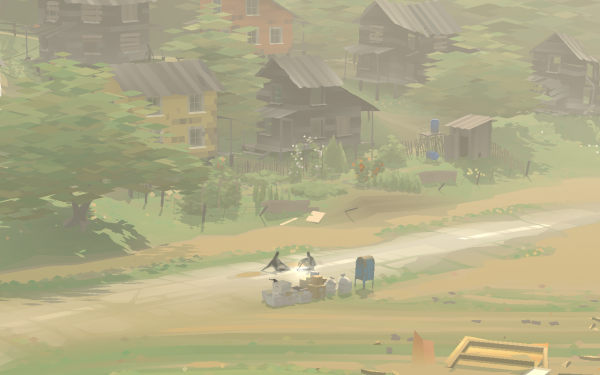
Initially drowned in floodwater, markers of new life emerge: the sputtering cough of a repaired airplane, the warble of music floating from a radio, and the chatter of characters taking on new roles in town and beyond. When the main cast first encounters the fabled 5 Dogwood Drive, characters marvel at the space’s roominess, conjuring up different futures where they can move in or set up shop. Whereas in previous acts, the repurposing of space by the Bureau of Reclaimed Spaces signified the sorrow of foreclosure and insurmountable institutional powers, the salvage efforts of Act V attempt to safeguard cultural memory and community ties. Maintaining and holding onto any sense of community is held in utmost importance, as Act V acknowledges the fragility of a vulnerable public. WEVP-TV producer Emily can be found crouching over the destroyed Video Databank archive, grieving the loss of the town’s communal library of artist videotapes, home movies, and filmed dream diaries. As backstory explains that a court order prevented the monopolistic Consolidated Power Company from influencing station programming, WEVP-TV was the one symbol of successful resistance against the ravages of corporate power. Now washed away, its destruction is a significant blow to morale. When physical structures crumble and people relocate or vanish entirely, the markers that comprise a community grow endangered. In response, Kentucky Route Zero offers the incorporeal solution of shared stories, bestowed knowledge, and mutual experiences as the deeper ties that bind a community even as the surface appearance of a neighborhood changes with time or tragedy. If a town no longer exists physically, it can exist psychically, through the bonds we forge with each other.
This spectral immateriality literally emerges via the ghosts that wander the town, intimating the longer history of a community no longer existing in a physical form. Visualized as ambling, silhouetted walkers that silently trek across the flooded landscape, they are the ghosts of Elkhorn Mine, the twenty-eight miners trapped underground when the tunnels collapsed, entombing them in floodwater. They are also the ghosts of Un Pueblo de Nada, or the “People of Nothing,” earlier settlers from Central America comprised of sociologists seeking utopia. And they are also the faded memories of people still living, flashbacks to moments of growth and anguish inscribed onto spaces. The ghosts provide us with traces of lived experiences, like an archive of memories that constitute the living body of a community, allowing us to remember and share in communal anxieties and joys. When the cat approaches these shadowy ghosts, memories trigger of lounging on hot tarmac, pulling up weeds in the garden, and drinking sweet tea as a reward. They also elicit the shame of the murder of an out-of-towner conscripted by the Company to dig an ill-fated drainage ditch, adding to the numerous dead that haunt Kentucky Route Zero.
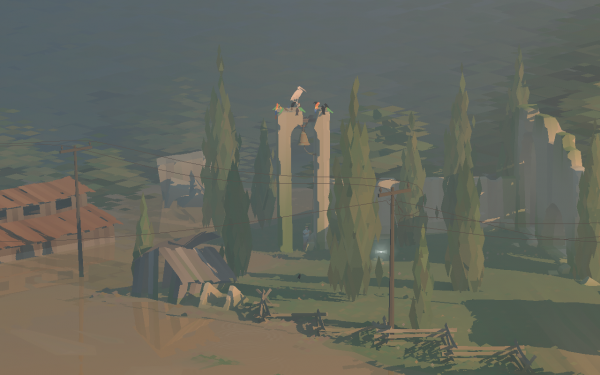
I mentioned in my examination of the game’s first act that at its core, Kentucky Route Zero is a ghost story, one in which some past offense must be remedied to exorcise this lingering hurt. Players discover WEVP-TV handyman Ron utterly disconsolate at the death of the Neighbors, two horses that are distant offspring of the original ones freed by the People of Nothing, before transforming his grief into productive rage against corporate injustice more broadly. Engaging in the lonesome act of preparing a proper burial site, he throws himself into work alongside other townspeople like Mary Ann, who paints a mural of the horses that will serve as their grave marker. The funeral that closes Kentucky Route Zero neatly completes the visual motif of buried horses originally begun in Act I with the Equus Oils gas station. Its aboveground façade sports a giant metallic horse head, but when Conway ventures downstairs, the underground space of hallways and gasoline reservoirs forms the shape of the horse’s body. Conway too remains underground, vanished somewhere among the other skeletal debtors in darkness. Act I anticipates his fate in a short digression where Conway visits an abandoned museum and examines a book with a “smudged and indecipherable” three-word phrase (Kentucky Route Zero?), with its closing image of a “one-legged man working an antique adding machine, surrounded by whiskey bottles” foreshadowing his conscription into the Hard Times distillery. As Conway’s antique truck lies abandoned belowground at the start of the final act, the game obliquely stages his own burial as well.
When all the remaining characters congregate around the burial for the Neighbors, Emily leads a hymn that slowly develops into a harmony of the townspeople’s voices. One by one, a gathering of ghosts appears among the characters, silently joining their act of mourning. This ceremony not only serves as closure for the horses, but as a collective grieving following decades of hardship and loss. “We’re gonna bury this town today, when we bury these horses,” the poet Nikki remarks. “It’s the same thing.” The camera slowly moves to an overhead view of the grave where the two horses lie. This funeral allegorically lays to rest the drowned miners encountered in the discarded helmets and literal ghosts hidden deep in Elkhorn Mine. When the song ends, the ghosts vanish, finally giving closure to the drowned workers, the various people who once lived here, Conway, and an entire way of life. In staging this funeral, Kentucky Route Zero offers a moment of collective healing, closing a chapter for the town but not necessarily ending its story. Some folks will leave the neighborhood, now freed from the obligations that bound them to it, yet some will remain of their own volition, nurturing a community once more. Later, Nikki observes that those who will rebuild the town will be doing so atop a grave, but that this is the reality everywhere: “The whole world is built on top of graves.” When the ghosts leave, only the bones remain.
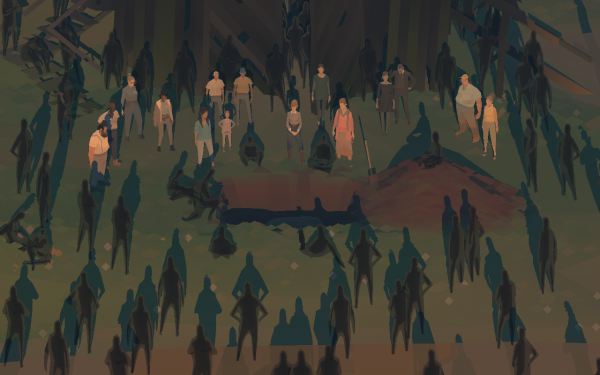
“Who are the ‘People’ now?” This is the question on Nikki’s mind after eulogizing the utopian People of Nothing who once resided in this town for over a century. Arcane references to their history are tucked away in flashback encounters, invoking doomed sociological experiments and dreams of a future devoid of hunger and strife. In a beautiful character study, an author named Luke for Medium suggests that they are called People of Nothing because “every single aspect of their culture was potentially replaceable” as they experimented with different conditions for living in a community. With the death of their final two horses, the People of Nothing no longer have living physical ties to the neighborhood, but entirely new lives will soon take their place, nurturing the seeds they planted. “I will stay here and care for your ghosts,” the musician Clara reassures Ron, ensuring the preservation of past residents’ contributions to the town. Not everyone makes it to the end unscathed, like Conway and the other indentured spirits on hard times, but Kentucky Route Zero urges us not to sit and despair. Emily suggests that the hardest thing about keeping an artistic community alive is “just getting people to show up,” to which Junebug candidly responds, “Sometimes you only need a few people.” This is the hopeful conclusion towards which Kentucky Route Zero has been heading, uniting people in their desire to create something new. The journey itself has been worthwhile because the accumulated companions and the shared stories have forged community bonds that will be carried into the future, ensuring the town’s survival.
At the very end of the game, we hear the plucking of a lonely guitar resting atop the gentle sounds of water, crickets, and cicadas. As the camera moves through groups of characters we’ve encountered throughout Kentucky Route Zero, it finally rests on the ethereal architecture of 5 Dogwood Drive, now converted into an open-air music space where its main cast now rests, settled among Conway’s antiques. The camera perched high above from a bird’s perspective, the structure resembles an ark floating in the floodwaters, a refuge for those set adrift, a repository of memories, a makeshift haven, a portal, a temple, a home. The main cast we’ve been following throughout Kentucky Route Zero may have reached their final destination and found necessary sanctuary, but a wealth of stories remain. Rita, the plucky host of WEVP-TV’s evening broadcast, remarks that “the work of history is to find a pattern in the unasked questions.” This concept is a key theme throughout the game, concerned as it is with characters in unclear states of remembering and forgetting. Some pine for a past that will never return, like Conway’s daydreams of a relationship with his beloved Lysette, or other figures who reminisce of coal mining jobs long gone. Flora, the girl briefly seen playing with Ezra in Act III, tells the young boy that she embarked on her own adventure, with her own companions, suggesting a parallel, unseen story much like Conway’s passage through Kentucky Route Zero. On its surface, the town may look vacant and depleted, a forgotten relic of an antiquated past. Flora’s fleeting comment to Ezra, however, intimates the many other Kentuckys that lie just below—stories of destitution, recovery, failure, hope, and change—waiting to be remembered.
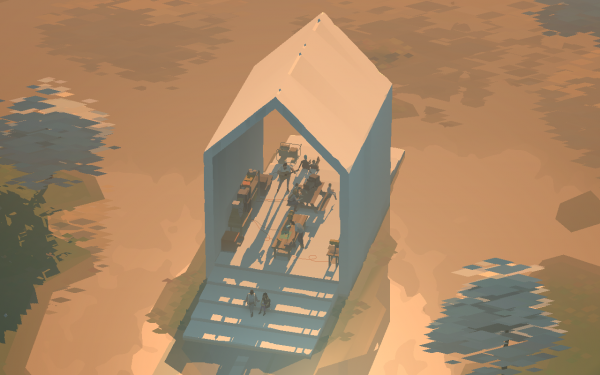
Miguel Penabella is a PhD student investigating slow media and game spaces. He is an editor and columnist for Haywire Magazine. His writing has been featured in Kill Screen, Playboy, Waypoint, and Unwinnable, and he blogs on Invalid Memory.